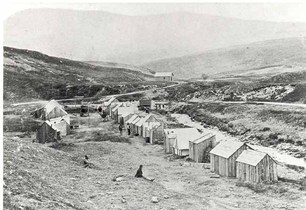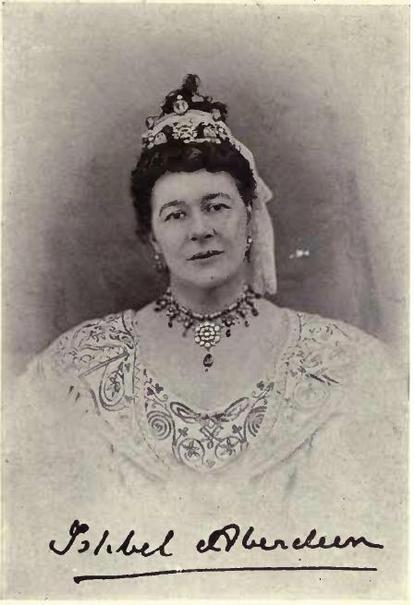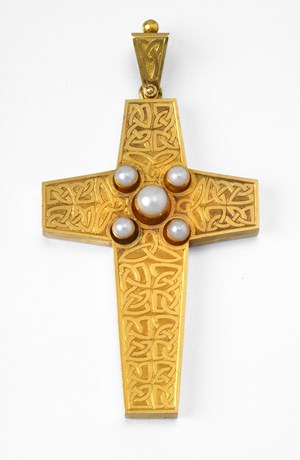 Baile an Or, the site of the Sutherland Gold Rush, taken by Alexander Johnston in 1869. Image courtesy of Suisgill.co.uk.
Baile an Or, the site of the Sutherland Gold Rush, taken by Alexander Johnston in 1869. Image courtesy of Suisgill.co.uk. The working lives of jewellers in Edinburgh - the historic and administrative centre of the industry in Scotland - played out in the streets and closes surrounding the West Port. The lives of these jewellers, and indeed of their fellow craftspeople throughout Scotland, looked very different at the end of the eighteenth century to how they did on the outbreak of World War I. New technologies brought about by industrialisation, the irruption of wealth, emerging groups of middle-class consumers and the decline of the aristocracy from the 1880s, saw the industry experience profound transformations.
Objects made by Scotland's jewellers - their materials, design, making and wear - can tell us about these changes. In addition, they can speak of much wider stories that take us across UK, Europe and across the world. In doing so, they represent a nexus of space and place concerning rural and urban, home and away.
The metals, gems and stones used in their production came from caves, mines, mountains and rivers in Sutherland, Montrose and the Cairngorms, as well as Africa, India and South America. The transformation of these raw materials into finished objects takes us through cutters and dealers in Amsterdam, and the centres of fashion in London and Paris, and back around to shops and workshops throughout Scotland.
 Ishbel Hamilton-Gordon, Marchioness of Aberdeen and Temair, c. 1900. Image courtesy of Wikimedia Commons.
Ishbel Hamilton-Gordon, Marchioness of Aberdeen and Temair, c. 1900. Image courtesy of Wikimedia Commons. Thinking about the stories contained within jewels always brings me to a quotation from Sherlock Holmes in 'The Blue Carbuncle'. As Holmes surveys the rare stone, holding it up to the light, he says:
... just see how it glints and sparkles. Of course it is a nucleus and focus of crime. Every good stone is. They are the devil’s pet baits. In the larger and older jewels every facet may stand for a bloody deed.
Holmes uses the blue carbuncle to highlight how the timelessness of jewellery objects enables them to build histories of their own; to contain traces of the people, places and events of their past. His observation draws attention to the troubling, more brutal aspects of the British empire and reminds the reader that the stories contained within material things often concern death, the destruction of communities and landscapes, and the insatiable human desire for increased wealth and status.
Jewellery objects functioned not only as markers of money and status, but as expressions of self adornment and as a facet of property relations. At a time when women, particularly married women, had few rights to their own wealth or assets, items of jewellery were particularly important items of property as well as important personal possessions which symbolised their biographies. These ideas are evident in the memories contained within the jewels of Scottish author, philanthropist and advocate of women's rights and social reform, Lady Aberdeen, which were stolen during her honeymoon. In Lord and Lady Aberdeen's joint autobiography, "We Twa", written over 50 years after the theft, she speaks with striking clarity about the things that were lost, which included highly valuable family jewels and wedding gifts made by Scottish jewellers, as well as:
the articles of less intrinsic value but possessing associations which made them irreplaceable. … a very pretty christening locket given me by my godmother, which I had worn continually as a child, and a lovely little old chatelaine given me by A. on our wedding day, in the form of an enamelled egg, inside which was a miniature globe representing the world, inside that again a blood-red heart. I had worn it till that very morning, when I put it back into the drawer, because a fastening was loose.
She describes the colours and form of these objects, and the deeply personal memories and attachments contained within them, with striking clarity. In doing so, she highlights how the things taken contained traces of the people who were special to her as a child; how they charted her journey through life; and how they symbolised her new status as a married woman. Thus, she highlights the different ways in which things contain both financial and symbolic worth and documents the life-stories of individuals and the traces of the people who have made, gifted and used them.
The work of nineteenth-century jewellers in Scotland's towns and cities tells us many different stories of home and nation, space and place. The objects they made, sold, altered and engraved contained layers of meaning, and individual and collective memories of real and imagined people and places. They tell us about gender and class experience, and illuminate details about the place of Scottish people and things in the wider world during a time of deep and wide-reaching economic, social and cultural change.
Sarah Laurenson | @reformlane

 RSS Feed
RSS Feed
